|
Alphabetical List |
|
|
|
|
|
|
|
County List and Topics |
|
|
|
Please sign my Guestbook and leave feedback |
|
The pages in this series are the result of an epic church crawl I undertook over one Bank Holiday weekend in 2019. Such is the richness of the mediaeval art concentrated in this area of Herefordshire, Shropshire and Worcestershire that I ask whether this might not be the “World’s Best Church Crawl”? Maybe you know a better one? I don’t personally but then this itinerary by design plays to the palette of mediaeval art that I love best. So I don’t expect everyone else to agree! Nevertheless, if you are a fan or even a casual browser on this site then I think you will agree that is a very special itinerary indeed. Perhaps you might follow it yourself and if you do you will also see an England that many feel no longer exists: an England of tiny villages and hamlets, narrow uncrowded roads, beautiful scenery and a discernibly slower pace of life. Above all a timeless England that gives the perspective of time on our present fevered political furore. The churches are all “open” (at the time of writing). All you need is a map (you will still need one even if you have sat-nav - you have been warned), a few nights accommodation, stamina and - unless you are as lucky as I was - a good waterproof! Please buy Church Guides and postcards and make donations. This is the best free show on earth: you can afford to be generous. Always sign guest books: visitor numbers are valuable collateral when churches apply for financial grants. Be grateful to those who prefer not to bow to mindless criminality or faceless insurance companies and keep their treasures accessible to all. There are some churches, often the very best and most unmissable such as Kilpeck, that were not part of this Church Crawl because I had visited them before. Where this is the case I will show where it might fit into a fuller itinerary. Each church is described briefly supplemented by some uncaptioned photographs. Click on the bottom of each description to see the associated gallery of more numerous, larger and fully captioned photographs. |
||||||||||||||||||||||||||||||||||||||||||||||||||||||
|
Day 4 - East from Tewkesbury |
||||||||||||||||||||||||||||||||||||||||||||||||||||||
|
This was the last day of my epic voyage of discovery around the Tewkesbury area. Since re-entering Worcestershire at the tail end of Day 3, we have left behind the remote little outposts of the Herefordshire and Dymock Schools of Norman architecture. Worcestershire’s churches are on average bigger and grander, reflecting the county’s denser population, not least of aristocrats eager to aggrandise and appropriate their local churches. The difference between the two counties is quite marked. At this point it is worth my reminding you how this epic and self indulgent trek came to pass. I was due to sing with my friends at a somewhat low-key music festival near Tewkesbury in August 2019. Diana was rather ill and so I travelled on my own, leaving me to fill in three days to kill before she travelled down for the festival itself and joined me. I used the time in a manic effort to exploring all of the churches on my “bucket list” within reasonable distance of Tewkesbury. In truth, interested in churches as Diana is and forebearing as she is, this was not an odyssey to inflict on another person in such a short timescale anyway. If you wanted to attempt it yourself in its entirety, especially taking in treasures such as Kilpeck and Deerhurst that I didn’t actually visit during this trail, then a week would allow a much more civilised pace, especially as you would be very lucky to enjoy the sort of glorious weather that I did. And if you are a real church enthusiast - as I hope you are - what a joy your journey will be. Never mind the churches, you should be able to lunch in ancient and hospitable country pubs, stay in friendly B&Bs with great hospitality and enjoy an England that you may not - especially if you are a foreign visitor - know exists. This area is as far removed culturally as Albuquerque is from New York or as Languedoc is from Normandy. This, my final day but not necessarily yours, covers some churches we visited on our way home from Tewkesbury to Northamptonshire. |
||||||||||||||||||||||||||||||||||||||||||||||||||||||
|
Stage 24 - Tewkesbury Abbey (Gloucestershire) - St Mary |
||||||||||||||||||||||||||||||||||||||||||||||||||||||
|
Why I Visited: One of the great Romanesque buildings in Britain. Simon Jenkins: ***** |
||||||||||||||||||||||||||||||||||||||||||||||||||||||
|
If you have been following in my tyre tracks slavishly (and I know you won’t) you will have spent another night in Tewkesbury. So far I have been very quiet about Tewkesbury Abbey. There are two reasons for this. Firstly, as you will know if you are a regular visitor to this site, I take the view that the Cathedrals and great Abbeys are well able to take care of themselves. Visitors flock to them, seeing them - rightly - as perhaps Britain’s greatest historical heritage. I like to champion the lesser known churches. Secondly, I have no insights into these buildings that other have not paraphrased, regurgitated and plagiarised a thousand times before. So on the whole I tend to write only about the rather less known abbeys and priories and not at all about the cathedrals, most of which let me assure you, I have visited. I need to remind myself - and you - however, that these abbey churches survive only as parish churches. They have been abbeys in name only since Henry VIII and Thomas Cromwell sacrificed them mainly to ameliorate Henry’s impecuniousness and, it must be said in all fairness, because they had become the over-mighty symbols of all that was wrong with the pre-Reformation Church. To suggest that you base yourself in Tewkesbury for this Trail, however, and then to ignore the undoubted gem that is Tewkesbury Abbey would be to stretch my scruples beyond all bounds of commonsense, so I am including a very small appetite whetter. Tewkesbury Abbey is the second largest parish church in England, second only to Beverley Minster in Yorkshire. Eighty per cent of it is the original and almost unaltered nave, chancel and central tower of the original Norman church that was started in 1102 and completed in 1121. To the east of the tower is the similarly intact ambulatory with a series of radiating chapels in the Decorated style and dating from the mid fourteenth century. The first monastic church was built here in AD715 by Dukes Oddo and Doddo (they sound like dwarfs from “The Hobbit”, don’t they?). It then went through the usual catalogue of disasters brought on by Anglo-Saxon internecine warfare and Viking depredation. Duke William grabbed it and the manor after the Conquest allegedly goaded by his wife who had been previously turned down in marriage by the Anglo-Saxon owner. “Hell hath no fury”, eh? He gave it to Sir Robert Fitz-hamon, the leader of his army in Normandy who had married William’s niece, Sibyl, along with Gloucester, Bristol, Cardiff, Glamorgan and lord knows where else. This cheese of very large proportions built an abbey at Tewkesbury to match his exalted status. Fitz-hamon died in battle in France in 1107, however, and his lands passed to Robert Fitzroy, Earl of Gloucester a bastard son of Henry I who completed the abbey. Fitzroy, by the way means “son of the king” and Henry VIII’s bastard son by Elizabeth Blount was Henry Fitzroy. if you were a bastard you could not be designated “Prince” as you couldn’t succeed to the throne so Fitzroy had to do. He died heirless so Henry II kept it, giving it to Richard the Absentee who in turn gave it to John the Utter Bastard who made it his main home until he became king,. It then passed to Gilbert de Clare, grandson of Fitzroy (I hope you are keeping up...). The de Clares and the Despensers - another of the great names of mediaeval England - held Tewkesbury for two hundred years. Tewkesbury, of course, is even more famous for hosting one of the pivotal battles of the Wars of the Roses on 4 May 1471. The Yorkist Edward IV had captured the ineffectual Lancastrian Henry VI (the only English monarch to reign twice, by the way). Henry’s far from ineffectual wife Queen Margaret of Anjou had landed from France with an army and was looking to ford the Severn at Tewkesbury to raise troops in Wales. She was cornered by Edward and his brothers Richard of York (the future Richard III) and George, Duke of Clarence and battle was joined in what is still known as the “Bloody Meadow”. The Lancastrians were driven back into the town where great slaughter ensued. Many took refuge in the abbey but the blood-drunk Yorkists killed many in the nave before the Bishop Strensham brokered a halt. That didn’t stop many of the fugitives being dragged out and executed in front of the abbey the next day. The strange thing is that I haven’t a great deal to tell you about the church! The abbey is extremely proud of its mediaeval and Victorian stained glass. Its tower is beyond doubt the finest Norman tower in England, a classic of its type. The nave is a breathtaking structure with the three stages of arcade, triforium and clerestory that are the signature dish of the great Norman abbeys. The Decorated east end is as fine and impressive as the Norman structure. Can I just say it’s gorgeous and leave it at that? |
||||||||||||||||||||||||||||||||||||||||||||||||||||||
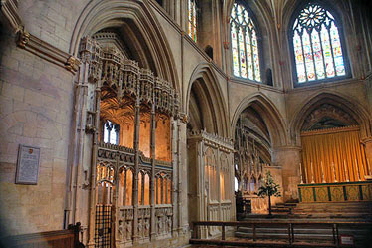 |
||||||||||||||||||||||||||||||||||||||||||||||||||||||
 |
 |
|||||||||||||||||||||||||||||||||||||||||||||||||||||
|
Stage 25 - Bredon (Worcestershire) - St Giles |
||||||||||||||||||||||||||||||||||||||||||||||||||||||
|
Why I Visited: Norman Porch; Mediaeval Tiles; Monuments. Simon Jenkins: ** |
||||||||||||||||||||||||||||||||||||||||||||||||||||||
|
Distance from Tewkesbury : 3 miles North West |
||||||||||||||||||||||||||||||||||||||||||||||||||||||
|
Bredon is one of those churches that just has a lot of interesting things without having something to make it truly famous. For myself the best thing here is the wonderful array of mediaeval tiles on the chancel steps that display the arms of the great local families. Simon Jenkins, and I am sure many others, raves about the 1611 monument to Sir Giles Reed and for sure it is a magnificent piece. There is the remnant of an easter sepulchre which is rare enough, albeit a poor relation indeed to the real stunners at Hawton in Nottinghamshire and Heckington in Lincolnshire; but then that is an impossibly high bar. A real rarity is the original vaulted Norman porch. There are two other Norman doorways in this church. Along the exterior of the nave are some Norman corbels. All this of this bears witness to a church that was built in around 1180, on the cusp of the transition between Romanesque and early Gothic. As in so many churches of the area, however, this building replaced a much earlier one because we know that a monastery was founded here in AD716 by Eanulph, son of King Offa of Mercia. Mercia, mainly due to the implacably pagan King Penda (I confess to admiring his refusal to follow the herd), was late to the Christian party but made up for it with a huge outpouring of zeal and monastic foundations subsequently. The Church Guide says that “Legend had it the Danes sacked the monastery around AD841”. So close to the River Avon ? Of course they did. The present church with its mixture of later Norman and Transitional remnants dates from around 1180. The evidence is in the Norman doors on the southern, western and northern sides. The tower is placed centrally although the church has no transepts. Its plan is fairly modest by Norman standards, an effect accentuate by its being heightened in about 1300. The Norman chancel was replaced in around 1300. The south aisle is a very impressive thirteenth century addition in Early English style. The lancet windows are doubled so we might date it to around 1250. It’s roof is gabled. The north aisle is a little later So it’s a fine church but its contents are more interesting than the building (and actually, that’s probably true of most churches. The mediaeval tiles are what really float my boat. They are fourteenth century forsooth with heraldic devices from numerous notable local families including Berkeley, Despenser (see Tewkesbury Abbey), Mortimer. Hastings and Bishop Trillek of Hereford who was once rector here. |
||||||||||||||||||||||||||||||||||||||||||||||||||||||
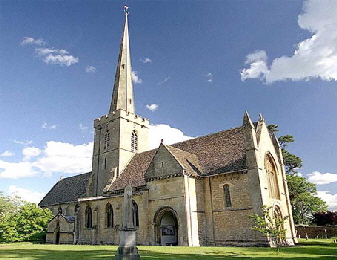 |
||||||||||||||||||||||||||||||||||||||||||||||||||||||
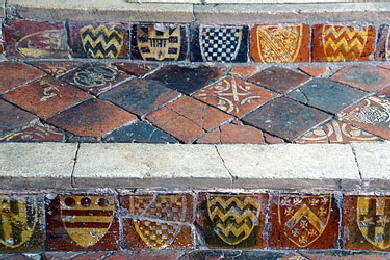 |
||||||||||||||||||||||||||||||||||||||||||||||||||||||
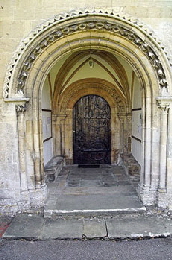 |
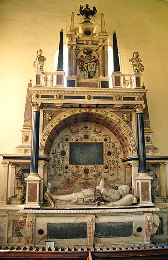 |
|||||||||||||||||||||||||||||||||||||||||||||||||||||
|
Stage 26 - Overbury (Worcestershire) - St Faith |
||||||||||||||||||||||||||||||||||||||||||||||||||||||
|
Why I Visited: Norman Font. Simon Jenkins: You Must Be Joking |
||||||||||||||||||||||||||||||||||||||||||||||||||||||
|
Distance from Bredon : 2 miles East |
||||||||||||||||||||||||||||||||||||||||||||||||||||||
|
One of the little perils of being known as an “expert” on old churches is the dreaded question: “Have you been to the church at Bugger-Me-On-The-Green”? Wearily one professes ignorance to the well-intentioned inquisitor sometimes gently imparting the information that there are some eight thousand pre-Reformation churches and I’ve visited a fraction of them. Then you hope you never see the person again so you don’t have to make excuses. Bed & Breakfast conversations are a particular danger here, although it serves us right for mentioning our interest, although not every English person wants to spend half an hour talking about the weather although many do. Anyway. for this Trail I was based in a lovely rural B&B at Kempley, a couple of miles outside Tewkesbury. On my last morning I was asked by another guest if I had been to Overbury or Little Washbourne. I hadn’t and I wasn’t planning to - until I looked them up in Pevsner and realised I have been a genuinely worthwhile tip off. So those are my next two churches. Before I talk about the church, we should mention St Faith. I was amazed to find there are twenty eight churches in England dedicated to her. She came from Agen in Aquitane. When Dacanius the Roman governor of Spain paid a visit he demanded that Faith and a number of others renounce Christianity. So far, so plausible not least because at that time the emperor was Diocletian who instituted the Great Persecution of Christians. Needless to say, Faith refused. Dacanius punished her by the very reasonable act of tearing off her breasts, beating her with reeds and then griddling her. You might wonder if a fourth century twelve year old girl really had breasts sufficient to tear off but one gets the impression that the first millennium Christian chroniclers got a bit of a frisson out of that kind of stuff. She is usually represented carrying her grill pan as she is in a north aisle window here. The church is another with a central tower. This tower is fifteenth century and in Perpendicular style. Either side of it are a Norman nave and an Early English chancel so there was obviously an earlier tower too. The Norman nave is heavily built with massive drum columns supporting arcades to both north and south,. It still has its Norman clerestory on both sides. The arcades show that the Norman church must have had two aisles but the clerestories are no visible externally due to later changes to their height and width. As at Ripple, the clerestory windows are tall and the deep splays reach down below the profiles of the arches. The church has mounted lights within these openings and this has the effect of giving the nave a rather spooky atmosphere as well as a strange light that produced one of the worst sets of photographs I have ever taken! I fiddled endlessly with my allegedly sophisticated camera but to no avail. The best feature, for my money, is the Norman font. The Church Guide admits that it has been much-repaired but it is still rather remarkable. It has just four large bold designs on a bowl that is goblet-shaped. There must be other Norman fonts around with similarly elegant shapes but I am struggling to think of one. Architecturally, the Early English chancel outshines the Norman nave. It is ribbed and vaulted with a sculpted boss at each of th two intersections. These are a bit of a throwback to the Norman era but whereas Norman bosses tended to be fantastical those at Overbury are human - one a king - showing some stylistic departure from Norman practice. The walls of the chancel too are very sophisticated for a parish church with attractive surrounds to the other otherwise run-of-the-mill EE lancet windows. Altogether, this is a very striking room and the church thus provides a striking comparison between the ponderous weightiness of English Romanesque and the sophisticated lightness of the early Gothic. What a difference a century made. |
||||||||||||||||||||||||||||||||||||||||||||||||||||||
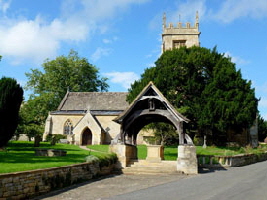 |
 |
 |
||||||||||||||||||||||||||||||||||||||||||||||||||||
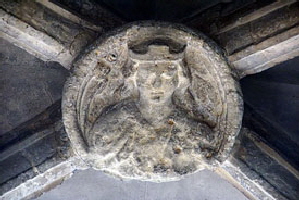 |
||||||||||||||||||||||||||||||||||||||||||||||||||||||
|
Stage 27 - Little Washbourne (Gloucestershire) - St Mary |
||||||||||||||||||||||||||||||||||||||||||||||||||||||
|
Why I Visited: I Love Tiny Churches! Simon Jenkins: Excluded |
||||||||||||||||||||||||||||||||||||||||||||||||||||||
|
Distance from Overbury : 4 miles South-East |
||||||||||||||||||||||||||||||||||||||||||||||||||||||
|
Little Washbourne is in the care of the Churches Conservation Trust. When you try to find it you won’t be surprised. You have to drive up a long track from the main road. When you reach the little cluster of buildings at the end and ask someone - if you are lucky - where the church is you will be told that you passed it a couple of hundred yards back and even then you will struggle to spot it. It is one of those “stuck in the middle of nowhere churches” that always thrill me. I am a total sucker for them. Little Washbourne was always a dependant of Overbury. It was built in the twelfth century and consists of a nave, chancel and a little bell turret that looks to me to have been added at some unspecified time later. The walls were originally all of rubble but ashlar facings were added to most of the nave in the eighteenth century. Restorations took place in 1912 and as late as 1961. It is quite remarkable and commendable that so much effort has been invested in keeping this little building standing. It passed to the CCT when it was obvious that the tiny population could no longer provide for its upkeep. I haven’t made any effort to “sell” this church to you because there is little here except a certain indefinable spirituality and sense of history. That’s enough for me and it if you are visiting the other more imposing churches in the vicinity what a shame it would be to omit this tiny church from your itinerary. |
||||||||||||||||||||||||||||||||||||||||||||||||||||||
|
Stage 28 - Elmley Castle (Worcestershire) - St Mary |
||||||||||||||||||||||||||||||||||||||||||||||||||||||
|
Why I Visited: Bizarre Font; Magnificent Monuments Simon Jenkins: ** |
||||||||||||||||||||||||||||||||||||||||||||||||||||||
|
Distance from Little Washbourne : 10 miles North |
||||||||||||||||||||||||||||||||||||||||||||||||||||||
|
And so, finally, to the last stage of this epic trek. It is another of those churches that just contains a great deal of interest. Simon Jenkins’s entry focuses almost exclusively on two magnificent monuments and although I am not one of the “Monuments Men” I have to say that these are special. That of William and Giles Savage and Giles’s wife is a wonder indeed. As predictable as Simon’s focus in monuments, is my own font fetish which was tickled by a font bizarrely supported by four sinuous “monsters” that have the demeanour of four cats. The bowl is Gothic but if so, then it was very early Gothic because these boys are decidedly Norman in appearance. The chancel here has herringbone masonry so we know it to be early Norman or even late pre-Conquest. Elmley Castle did indeed have a castle until the sixteenth century and it was built by Robert Despenser in the eleventh century. We’ve already met the Despenser family and their successors the Beauchamps at Tewkesbury Abbey. In truth, the architecture here is unexceptional in the main which is not to say that it is not of interest; just that it has gone through the regulation development stages during the Gothic era that have left little to stir the blood; which is not to say that this is nlt a very pleasant church, although more so perhaps inside than out. Apart from the Despenser monument there is another beauty to the first Earl of Coventry (d.1699). There is an interesting story surrounding this that I will mention in the Gallery. Inside the porch there are Norman carvings of a rabbit and of a pig. We don’t know where in the church they originated. |
||||||||||||||||||||||||||||||||||||||||||||||||||||||
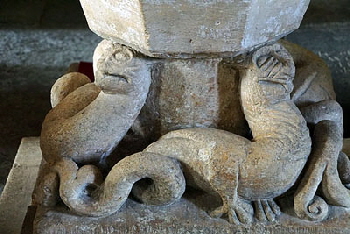 |
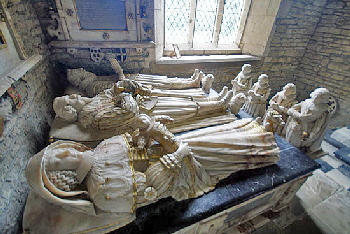 |
|||||||||||||||||||||||||||||||||||||||||||||||||||||
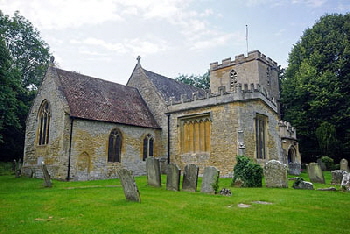 |
||||||||||||||||||||||||||||||||||||||||||||||||||||||
|
Epilogue |
||||||||||||||||||||||||||||||||||||||||||||||||||||||
|
When I wrote about Byton Church, I reflected upon the perspective that ancient church gave me about the then fractious and over-heated debate about Brexit. As I write this epilogue, the UK is in about the sixth week of its Covid-19 lockdown. Suddenly all talk of Brexit is on the back burner. Who knows, maybe we will all now have a new sense of perspective? More perspective is also available to those who might care to compare what is, to our Western eyes, a shocking death toll to the number of people who die each day in conveniently obscure corners of the globe from starvation or wholly preventable diseases. As we chuck increasingly improbable amounts of money at supporting the economy during the pandemic (and I am NOT saying we shouldn’t be doing that), would anyone care to estimate how many lives could have been saved around the globe if even a fraction of that amount had been made available as humanitarian aid and medical programmes over, say, ten years? I am not making a political point here, I am just searching for perspective, As someone more or less obsessed by mediaeval history I also can’t overlook the the Great Plagues of the fourteenth century which eliminated 40-60% of the world’s known population. The UK population did not recover to its pre-Plague levels until 1601. Perspective again. Imagine if Covid 19 had a mortality rate of 25%. Would our highly sensitive inter-dependent social and infrastructure institutions be able to carry on? Here is my perspective. We might enjoy history but we should never forget that we are part of history. Anyway, after that bit of self-indulgent navel-gazing, this is the end of the World’s Greatest Church Trail. If just a few people follow even a part of it then it will all have been worthwhile. Travelling the whole route in just four days was taxing. Reading it might have been a bit of a route march. Writing it has been like running several marathons! So why bother? It is my view that church tourism has been neglected in this country. Individual churches are proud of their heritages. Cathedrals and some priories are full-blown tourist attractions. Some parish churches produce superb Guide Books and other do not but, in any event, you only read these when you get there unless the church is one of the growing number that have the nous to put theirs on their websites. Some parts of some dioceses occasionally produce leaflets about local churches. Sometimes these are rather devalued by a laudable but slightly self-defeating habit of giving space to the mediocre (but always loved, it must be said) alongside the near-sensational. There is never space - because of printing costs - to develop themes. They tend to be thumbnail sketches. The Churches Conservation Trust (there are few organisations more admirable) produce excellent - and free - guides to their own churches in each county. All of this is admirable. But it’s nowhere near enough. Worse still, it is based on what used to be called in the organisation I worked in as “silos”. A silo in this context might be a county or a diocese or a local authority area. People don’t base their tourism on such criteria. They want to know what’s really worth visiting and they don’t want someone omitting places that just happen to be over the geographical or organisational border. Oh, and they want to know that the place will be open when they get there! I will give you an example of the silo effect. I live near the superb town of Stamford in Lincolnshire. It attracts hordes of tourists to its Georgian streets. Its Tourist Information Office has leaflets that describe all of the several mediaeval churches in the town. Those churches are a worthwhile visit, there is no denying that. Yet just two miles away is Tickencote Church, a nationally important Norman structure. But Stamford Town Council is not interested in Tickencote which is in the county of Rutland. Nor is it interested in nearby Castor and Barnack Churches which are also of national importance but which are both in Cambridgeshire. If you put together Barnack with Earls Barton and Brixworth Churches in Northamptonshire and with Great Paxton and Wittering in Cambridgeshire you have a fascinating Anglo-Saxon church circuit. There are numerous other possibilities. They don’t have to be just about the church buildings either. How about a national trail of churches where famous poets and writers are interred or which have literary associations? How many Americans might be interested in a tour of churches associated with World War II USAF bases? You get the idea? This Trail covers five counties: Staffordshire, Shropshire, Herefordshire, Gloucestershire and Worcestershire. It too is constrained - in this case by my own particular interests and the original reason I was in Tewkesbury - to sing in a music festival! I wanted to show, however, just how much of interest can be uncovered in a roughly triangular area with no side of that triangle being more than forty miles long. If church tourism in this country was recognised as being a national or regional benefit then it needs this kind of focused effort. If I had been doing this work for an official body I would have been suggesting places to stay (not just in Tewkesbury where I based myself) as well as perhaps pubs and restaurants, all of which could pay for the publicity!. What also can be overcome is the issue of cost. A website costs you the services of a writer and a web designer. But you can have just about as many photographs and as much text as you like. And much is available already - I already agree numerous requests for re-use of my own images. Why does this matter? It matters because a few years ago a few idiots wrote a report for the government called “The Taylor Report” into the funding of English parish churches. What they recommended - much of it laughable - is for a different article but what scandalised me is that this bunch of worthies and “names” from the “heritage industry” managed to ghoulishly rake over every penny of public expenditure pertaining to parish churches without critically examining it (did you know National Lottery funding is “public expenditure”, by the way?) or ascribing one penny of contribution from these churches to the British tourist economy. They didn’t even mention the growth in church visiting attributable to the burgeoning interest in genealogy. It was, depending upon your point of view, either a deliberate attempt to distort the situation or, as I prefer to think, a crass omission by a bunch of amateurs that casually sold this vital part of England’s heritage short. Amongst the “contributors” - presumably well-remunerated for doing very little work - was one Simon Jenkins. Nice one, Simon. Do us all a favour and stick to journalism and writing books in future, mate. |
||||||||||||||||||||||||||||||||||||||||||||||||||||||
|
Click Here to Return to the Great English Churches Home Page |
||||||||||||||||||||||||||||||||||||||||||||||||||||||